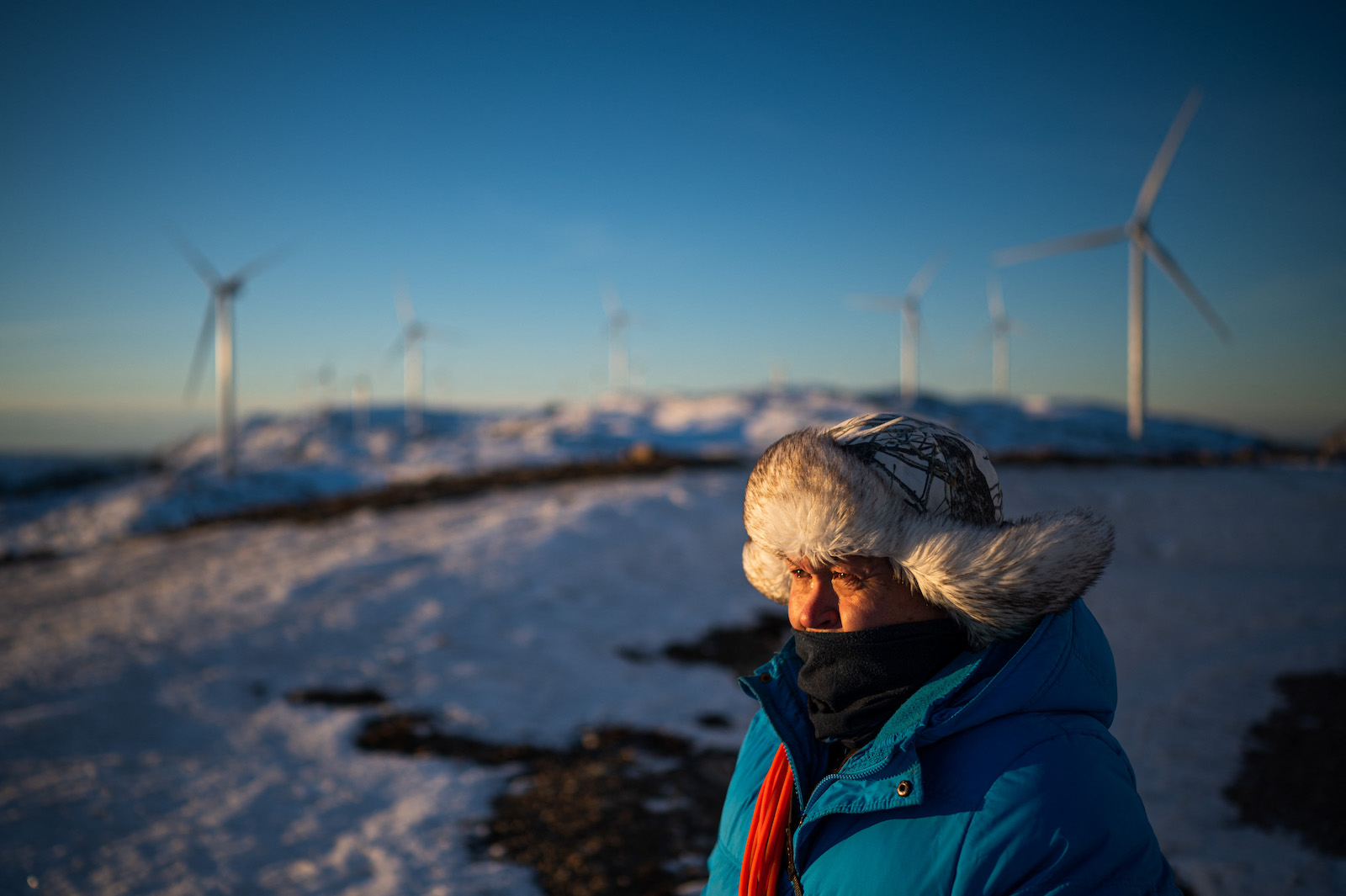The lávvu is set up in the traditional way: three, debarked birch rods holding up a cloth exterior. The lávvu, a traditional Sámi structure that resembles a teepee or a tent, is insulated with reindeer skins, and in the center, on a floor of twigs, a hearth. Typically a fire would be burning, but for now, a plant stands.
Traditionally, one doesn’t stand inside a lávvu save to enter and sit, so Mihkkal Hætta, the 22-year-old Sámi organizer from the village of Kautokeino, Norway, gestured to me to sit on the soft reindeer pelts.
“Welcome,” said Hætta. “I’ve been staying here for three weeks now.”
With the door closed, fresh air circled through the dwelling from an opening at the top of the lávvu. It was remarkably quiet inside, and soothing.
Outside stood the Norwegian Parliament. Street musicians busked for tourists, scooters and cars flew by, and dog walkers filed past Hætta’s temporary home. A cluster of Sami youth and other environmental activists also gathered. Curious passersby stopped to ask what was going on. Most asked what a lávvu was doing on official government property.
“I came here on September the 11th because it’s been 700 days since the Supreme Court ruled in favor of [the Sámis from Fosen],” Hætta would explain. “It’s quite unbelievable that a state like Norway lets human rights violations continue for 700 days. And it’s still ongoing.”
Hætta said most people from Oslo who come to the lávvu say they support him, but in the early days of his protest, there were several incidents: a rock band tried to break in one night and another time, someone stole some of his clothing.
Hætta’s presence in Oslo is becoming a familiar one — as are his comrades, and their attempts to bring attention to the Fosen case. On October 11, 2021, Norway’s Supreme Court ruled that the Fosen wind farm near the city of Trondheim, on the nation’s central-west coast, violated the rights of Sámi reindeer herders, the cultural rights of the Sámi people, and were constructed illegally.
Now, on the eve of the two-year anniversary of the court’s ruling, Hætta’s one-month protest serves as a reminder that despite Norway’s international renown for human rights advocacy and standards, Indigenous peoples inside the country’s borders still have no recourse to justice.
“I became really angry, losing more and more hope and losing more and more faith with the government,” said Hætta. “So I decided to put up a lávvu here outside the Norwegian Parliament to remind them that this is still ongoing.”
While Hætta’s protest has gone on for a full month, he’s not alone, and it’s not his first. By night, allies and friends look out for him, taking turns on night watch shifts outside the lávvu to keep him safe. And with the exact anniversary of the court ruling only one day away, more and more supporters are arriving to support, with buses coming from Sámi villages and communities across Sápmi — the traditional territory of the Sámi stretching from Russia across northern Finland into Sweden and Norway.
“I’m never alone here,” he said. “I couldn’t do this if I was alone. I have a lot of people around me.”
Hætta first became involved with the Fosen case earlier this year. On February 23, exactly 500 days after the court’s ruling, the Norwegian Sámi Association’s Youth Committee, also known as NSR-N, began occupying the Ministry of Petroleum and Energy in protest of the Norwegian government’s inaction after the verdict. Hætta took part.
During the protest, nearly 30 demonstrators, including Hætta, were arrested and another 90 removed from the Ministry’s property by police. Over the course of a week, Sámi youth organizers were joined by land and rights defenders from Young Friends of the Earth Norway, Greenpeace, Greta Thunberg, and nearly 2,000 additional supporters. Human rights campaigners eventually shut down 10 ministries and ended their protest outside Norway’s royal palace.
In the wake of the actions, the Minister of Petroleum and Energy delivered an official apology to reindeer herders in Fosen and acknowledged that the wind park constituted a human rights violation, while the Sámi Parliament of Norway demanded the windmills be demolished and the area restored to reindeer grazing land. Instead, however, Norwegian officials have attempted to negotiate with reindeer herders in order to keep the Fosen wind park operational.
“It is impressive to see the despair many young people express over this matter. I think it underlines how important it is that we find a good solution in this case,” said Petroleum and Energy Minister Terje Aasland in an email. “But demolition of the wind farms in their entirety is not a likely outcome either of a decision-making process or of a mediation process.”
“There is no agreement on what state action entails,” said Áili Keskitalo, a political counselor at Amnesty International Norway. “But what is obvious is two years after the verdict, and when no other solutions have been found, the state is obliged to stop the violations of human rights.”
Much of the energy produced at the $1.3 billion Fosen wind park will be part of Norway’s green transition — approximately 98 percent of the country’s electricity comes from renewable sources. However, in 2021, almost 17 percent of that electricity was exported to other European countries. There are nearly 53 wind farms operating, or under construction, in Norway right now, and it’s estimated that another 100 licenses have been granted by the government with many slated for construction in Sápmi.
“By failing to enforce a judgment by its highest Court, the Norwegian government is denying the rights of Indigenous Sámi to their cultural heritage and livelihoods,” said Carla Garcia Zendejas, Director of the Center for International Environmental Law’s People, Land and Resources Program in Geneva, Switzerland. “Sámi leaders should not need to put themselves at risk to ensure that effective justice is carried out. Not only does this cast a shadow on the Norwegian government’s commitment to upholding human rights obligations, it questions the rule of law.”
In June of this year, Hætta marked 600 days of inaction by joining with NSR-N and Motvind Norge, an organization that opposes the construction of wind turbines on conservation grounds, to demonstrate outside the Norwegian Parliament again, while activists blockaded the entrance to the wind park at Fosen.
Recently, 24-year-old cultural worker Emily Cottingham from Tønsberg and 26-year-old Daniel Fuller were guarding the lávvu. Fuller, who is Irish-British, works at a nearby cafe and became involved when he began offering coffee to Hætta and other activists outside the Parliament.
“I have always been interested in decolonization, having studied this,” said Fuller. “When I saw that Mihkkal moved into the lávvu, I realized that it was time to put my theory into practice.”
Then there’s Israel Nebeker, an American musician from Oregon who has come to Norway to trace his Sámi roots. When Nebeker heard about the Fosen case, and the actions taking place, he extended his trip.
“It feels important to be at this demonstration, to show my support for the Sámi at Fosen, and to hold the government accountable to its own laws,” said Nebeker. “It’s time for the government of Norway to protect the rights of Sámi, instead of continuing a history of brutal injustice.”
In 1981, Sámi organizers began demonstrations in Oslo to protest a proposed hydroelectric dam in Sápmi. Known as the Alta Action, Indigenous leaders occupied a government building and began hunger strikes. While efforts were unsuccessful in stopping the dam from being built, the moment marked a major turning point in Indigenous resistance in the region.
“When my father lived in Oslo as a young man, he attended the Alta demonstrations,” said Nebeker. “The Sámi have been fighting for far, far too long.”
Demonstrations are expected to begin tomorrow as more human rights campaigners make their way to Oslo. Sámi people that have worn gáktis, traditional clothing, are wearing them inside out — an old Sámi tradition that communicates protest. When Sámi people turn their gáktis inside out, it signifies resistance.
“It’s completely despicable for a country like Norway to ignore its own courts and laws,” said Hætta. “It’s a human rights violation, and it’s been going on for 729 days.”





